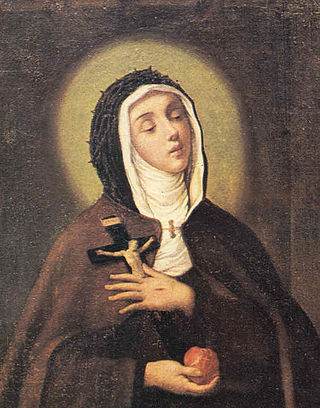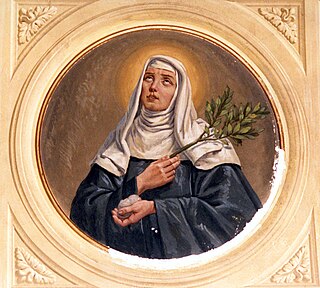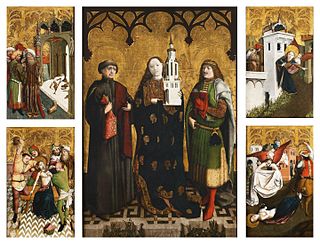Life and martyrdom
She was born in the Levant in the eighth century AD to a rich family living in Syria and when she grew up, she committed her life to chastity in honor of Jesus Christ. She went to the monastery of the Virgins in Akhmim and became a nun. At the age of 26, she became the head of the monastery in the era of Pope Michael I. [1] [2]
During a period of turmoil that was experienced in the era of Marwan II Caliph of the Umayyad Caliphate, some of his soldiers attacked the monastery of the Archangel Michael for the purpose of plundering and raping nuns. When they saw Veronica and her beauty, they decided not to kill her, but instead gift her to the Caliph as a slave.
When Veronica learned of their plans, she deceived them by telling them she possessed magical oil that can protect them in battle. To convince the soldiers of its effectiveness, she applied the oil to her neck and told them to strike her. She knelt down and prayed to Christ to be a virgin martyr in his name. One of the soldiers then struck her with his sword, resulting in her decapitation. Shocked by the outcome, the soldiers then fled the monastery without plundering anything inside or harming the nuns. Veronica's sacrifice is believed to have saved the other nuns in the monastery. [1] [3]

The Dormition of the Mother of God is a Great Feast of the Eastern Orthodox, Oriental Orthodox, and Eastern Catholic Churches. It celebrates the "falling asleep" (death) of Mary the Theotokos, and her being taken up into heaven. The Feast of the Dormition is observed on August 15, which for the churches using the Julian calendar corresponds to August 28 on the Gregorian calendar. The Armenian Apostolic Church celebrates the Dormition not on a fixed date, but on the Sunday nearest 15 August. In Western Churches the corresponding feast is known as the Assumption of Mary, with the exception of the Scottish Episcopal Church, which has traditionally celebrated the Falling Asleep of the Blessed Virgin Mary on August 15.

Saint Simon the Tanner, also known as Saint Simon the Shoemaker, is the Coptic Orthodox saint associated with the story of the moving the Mokattam Mountain in Cairo, Egypt, during the rule of the Muslim Fatimid Caliph al-Muizz Lideenillah (953–975) while Abraham the Syrian was the Pope of the Coptic Orthodox Church of Alexandria.

Menas of Egypt, a martyr and wonder-worker, is one of the most well-known Coptic saints in the East and the West, due to the many miracles that are attributed to his intercession and prayers. Menas was a Coptic soldier in the Roman army martyred because he refused to recant his Christian faith. The common date of his commemoration is November 11, which occurs 13 days later on the Julian calendar.

Veronica Giuliani was an Italian Capuchin Poor Clares nun and mystic. She was canonized by Pope Gregory XVI in 1839.

Marina, distinguished as Marina the Monk and also known as Marinos, Pelagia and Mary of Alexandria, was a Christian saint from part of Asian Byzantium, generally said to be present-day Lebanon. Details of the saint's life vary.

The Monastery of Saint Mary El-Sourian is a Coptic Orthodox monastery located in Wadi El Natrun in the Nitrian Desert, Beheira Governorate, Egypt. It is located about 500 meters northwest of the Monastery of Saint Pishoy.

Veronica of Milan was an Italian nun in the Augustinian Order. She was reputed to have received frequent visions of the Virgin Mary, and her local cultus was confirmed by Pope Leo X in 1517.

The title Virgin is an honorific bestowed on female saints and blesseds, primarily used in the Eastern Orthodox Church and the Catholic Church.
St. Mother Irini was the Coptic Abbess of the St. Philopateer Mercurius’ Convent in Old Cairo, Egypt and an influential figure in the Coptic Christian community of Egypt.

Phebronia of Nisibis, also known as Phebronia of Sebapte, was a nun at Nisibis. She suffered persecution under Diocletian, who offered her freedom if she renounced her faith and married his nephew, Lysimachus, who had been leaning towards conversion to Christianity. Febronia refused and was tortured, suffered mutilation and death. Lysimachus, witnessing her suffering, converted.
Saint Mohrael is a Coptic Saint and Martyr. She was martyred in the 4th century AD at the age of 12 years.

Mercurius was a Roman soldier of Scythian descent who became a Christian saint and martyr. He was born in the city of Eskentos in Cappadocia, in Eastern Asia Minor. According to Christian tradition, he was the soldier who killed Julian the apostate during his campaign in Persia. Saint Mercurius was also widely known by his Arabic-language name Abu-Sayfain, Abu-Sifin or Abu-Sefein in Egyptian Arabic which means "father of two swords", referring to the second sword given to him by the Archangel Michael.

Saint Barbara, known in the Eastern Orthodox Church as the Great Martyr Barbara, was an early Christian Greek saint and martyr.

Saint Demiana and the 40 virgins was a Coptic martyr of the early fourth century.

Abanoub or Abanop or Abanoub Al-Nahisy, is a 4th-century Christian saint and martyr from Egypt. His name means Father of Gold in Coptic. He was born in Nehisa in the Nile Delta to Christian parents. Abanoub was 12 years old when he was killed and beheaded, after being tortured for refusing to leave Christianity. His feast day is July 31. His relics are preserved in St. Virgin Mary and St. Abanoub Churches in Sebennytos, Egypt. His title is often The Child Martyr.

December 9 - Eastern Orthodox liturgical calendar - December 11

The Convent of Saint Thecla is a Greek Orthodox convent in Maaloula, Syria. It is administered by the Greek Orthodox Patriarchate of Antioch. The convent was built in 1935 around the grotto of St. Thecla.
Athanasius III was the Patriarch of Antioch and head of the Syriac Orthodox Church from 724 until his death in 739/740.

The Holy and Ancient Archdiocese of Jerusalem, All Palestine, and All the Near East or the Coptic Orthodox Patriarchate in Jerusalem, is a Metropolitan Archdiocese of the Coptic Orthodox Church, which is part of the wider communion of the Oriental Orthodox Church. It is headed by the Coptic Orthodox Metropolitan Archbishop of Jerusalem, the incumbent being Metropolitan Archbishop Antonious of Jerusalem since 2016. Its jurisdiction covers those Coptic Orthodox Christians living in the Near East; with churches and monasteries in the State of Israel, State of Palestine, the State of Kuwait, the Hashemite Kingdom of Jordan, the Lebanese Republic, the Syrian Arab Republic, and the Republic of Iraq. The adherents are largely of Coptic Egyptian descent, mainland Coptic migrants and their descendants. The archdiocese is based at St Anthony's Monastery, in the Christian Quarter of the Old City of Jerusalem, beside the Church of the Holy Sepulchre.
















